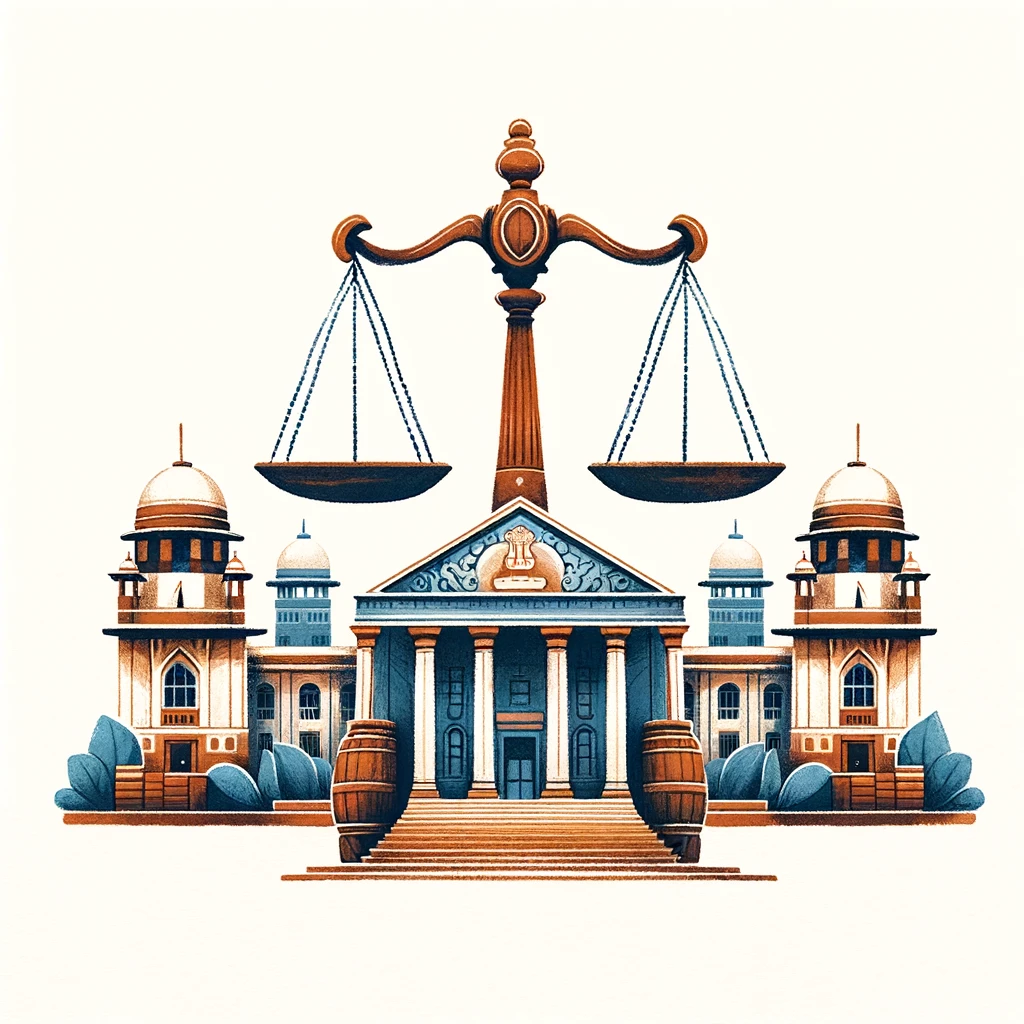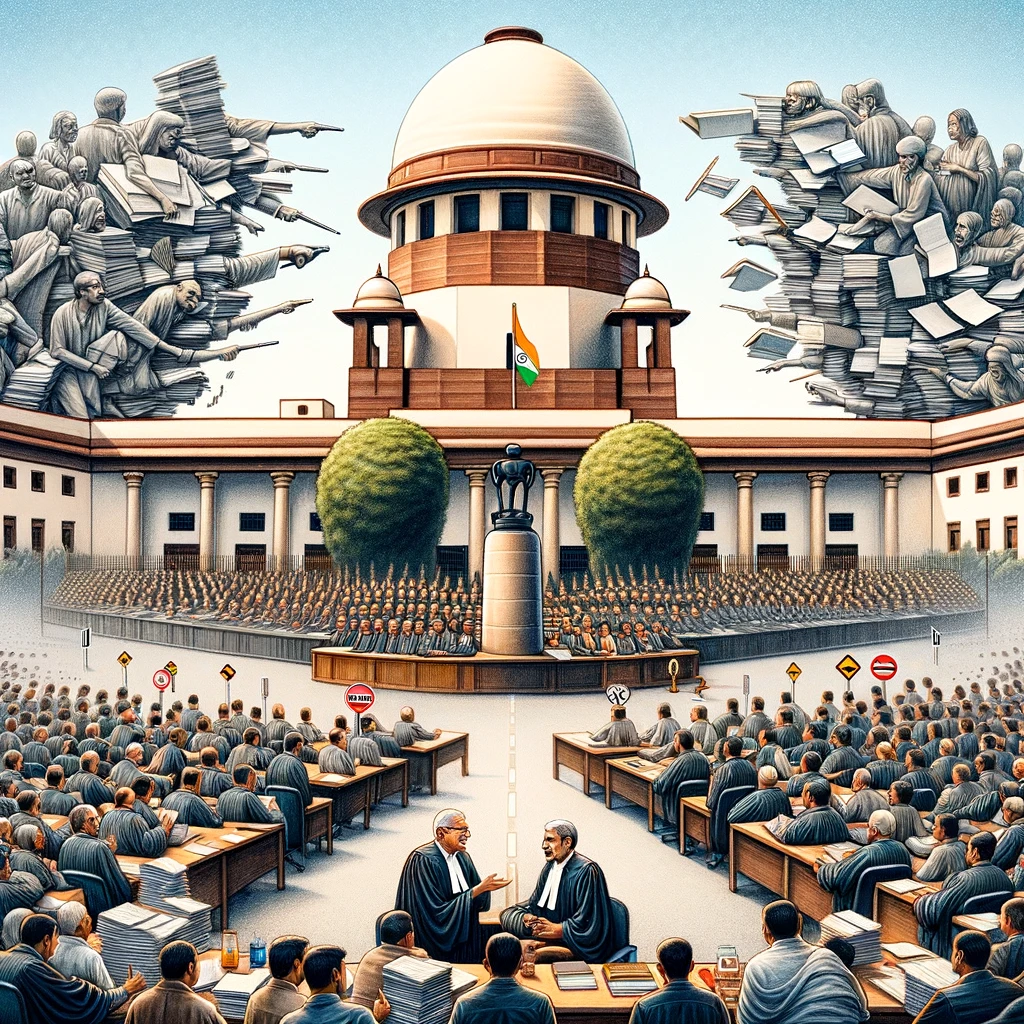
In the wake of an alarming backlog of cases, the Supreme Court of India stands at a crossroads, necessitating a structural overhaul to enhance its efficiency and accessibility. As of September 2023, the apex court grapples with over 80,000 pending cases, a situation aggravated by a combination of factors including a shortfall in judge strength, infrastructural deficits, and an inundation of frivolous litigations. This editorial deals with the crux of the issue, detailing the evolutionary journey of the Supreme Court since its inception, its role in the Indian judicial system, and the pressing challenges it faces today. It further sheds light on pragmatic reform measures, such as increasing the number of working days, establishing regional benches, and addressing infrastructural needs, which could significantly alleviate the case backlog. By adopting these reforms, the Supreme Court can ensure a more streamlined, accessible, and effective judiciary, reinforcing its cornerstone role in upholding justice and the rule of law in India.
Relevancy for UPSC Aspirants
The editorial talks about how the Supreme Court is dealing with too many cases and needs reforms. It’s important for UPSC exam takers, especially for papers on Indian politics and governance. The article looks at the history and structure of the Supreme Court and the problem of too many pending cases. It also talks about Article 124 of the Constitution and the challenges faced by the courts, like having too many cases and not enough resources. The editorial suggests solutions like creating courts in different regions and working more days. It’s a good resource for students preparing for the UPSC exams, helping them understand how the judiciary works in India and think about ways to improve it.
Introduction to the Supreme Court
The Supreme Court is the highest court in India according to Article 124 of the Constitution. It deals with important legal matters and has the power to make final decisions on cases involving the Constitution, laws, and fundamental rights.
Powers and Jurisdiction
The Supreme Court can hear cases where people disagree on what the Constitution means, whether laws are fair, or if someone’s basic rights are protected. It’s also the last place where people can appeal for both civil and criminal cases.
Composition of the Supreme Court
The Supreme Court is led by the Chief Justice of India and can have up to 34 other judges. These judges are chosen by the President of India.
Functions and Procedures
The Supreme Court follows its own rules and ways of doing things. It can make different types of decisions and give orders on legal matters.
Evolution of the Indian Supreme Court
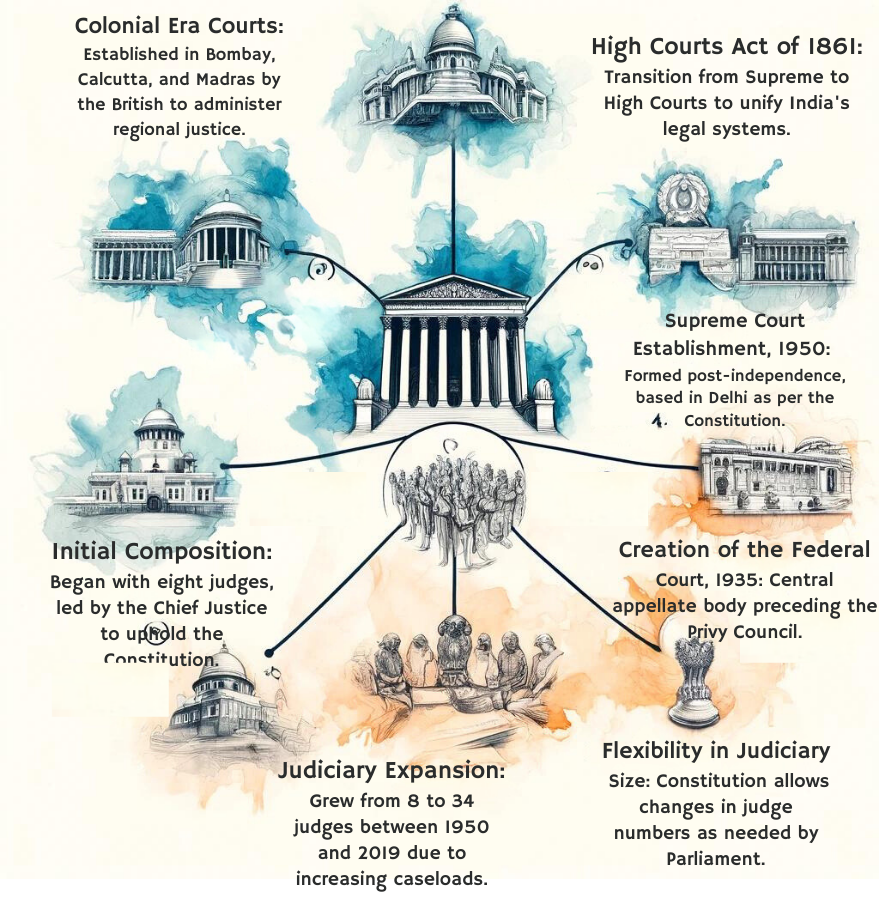
Colonial Era Courts: During the colonial period, there were three separate Supreme Courts in Bombay, Calcutta, and Madras. These courts were established by the British colonial government to administer justice in these regions.
High Courts Act of 1861: The Indian High Courts Act of 1861 replaced the Supreme Courts with High Courts, which were set up in different regions of India. This act aimed to streamline the judicial system and bring about uniformity in legal proceedings across the country.
Creation of the Federal Court: In 1935, the Government of India Act created the Federal Court of India. This court served as an appellate body, hearing appeals from the High Courts and acting as the final court of appeal before cases could be taken to the Privy Council in England.
Post-Independence Constitution: India adopted its Constitution in 1949, and the Supreme Court, as we know it today, was established on January 28, 1950. This happened just two days after India became a republic. The Supreme Court was founded under Article 124 of the Constitution, and its location was fixed in Delhi as per Article 130.
Initial Composition: The first Supreme Court after independence consisted of eight judges, including the Chief Justice of India (CJI). These judges were tasked with interpreting and upholding the Constitution and laws of the country.
Expansion of the Supreme Court: Over the years, the workload of the Supreme Court increased significantly, leading to a backlog of cases. To address this, Parliament passed laws to increase the number of judges on the Supreme Court. The number of judges was raised from eight in 1950 to 11 in 1956, 14 in 1960, 18 in 1978, 26 in 1986, 31 in 2009, and finally to 34 in 2019. This expansion was done to ensure timely justice and effective functioning of the highest court in India.
Constitutional Authority for Expansion: Article 124 of the Constitution gives Parliament the power to determine the number of judges on the Supreme Court. This provision allows for flexibility in adjusting the court’s strength based on the workload and judicial requirements of the country.
Jurisdictions of the Supreme Court of India
Three Main Roles: The Supreme Court has three types of jurisdiction: original, appellate, and advisory.
- Original Jurisdiction: This allows the Court to hear certain cases directly, like disputes between states or between states and the central government.
- Appellate Jurisdiction: This is where the Supreme Court acts as the highest court of appeal, reviewing decisions from lower courts.
- Advisory Jurisdiction: The Court can give its opinion on legal questions when the President of India asks for advice.
Constitution Benches: These are special panels of five, seven, or nine judges that handle major constitutional questions. The size of the bench depends on the Chief Justice of India, who oversees the Court’s roster.
Article 145(3): This rule states that at least five judges must sit when the case involves a major constitutional issue or when the President seeks the Court’s advice on a legal matter.
Overall, the Supreme Court plays a major role in interpreting the Constitution and serving as the final court of appeal in the country. The Chief Justice of India decides how many judges should hear each case based on its significance and complexity.
An Overview of Supreme Court Case Backlog
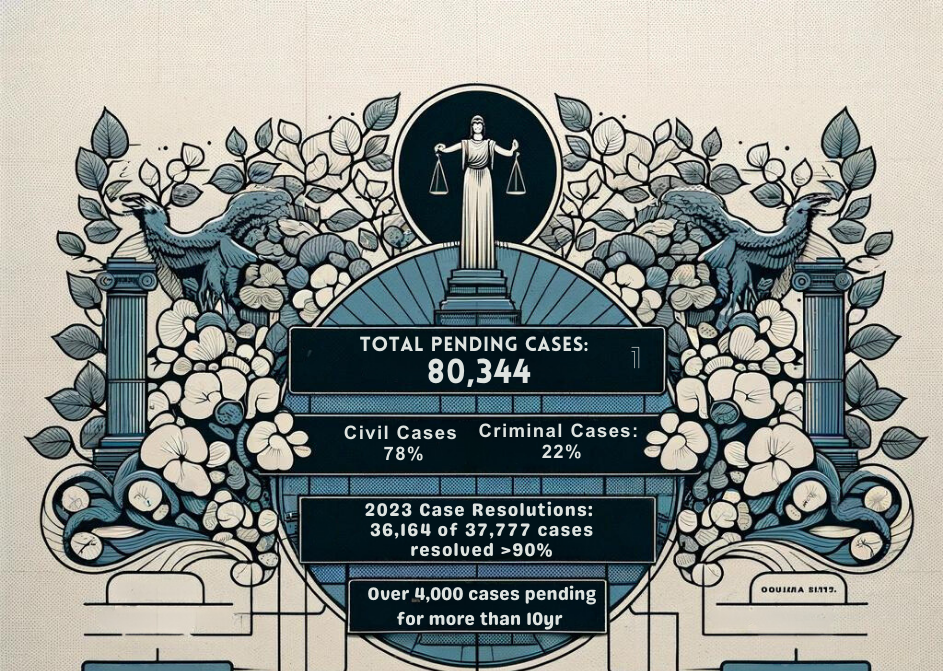
- As of September 2023, the Supreme Court had a total of 80,344 cases pending.
- A large majority—78%—are civil cases, while the remaining 22% involve criminal matters.
- The Court has managed to resolve 36,164 out of 37,777 cases filed in 2023, showing a high rate of case disposal.
- Despite this, over 4,000 cases in the Supreme Court have been pending for more than ten years, indicating a significant backlog.
Reasons Behind the High Number of Pending Cases in the Supreme Court
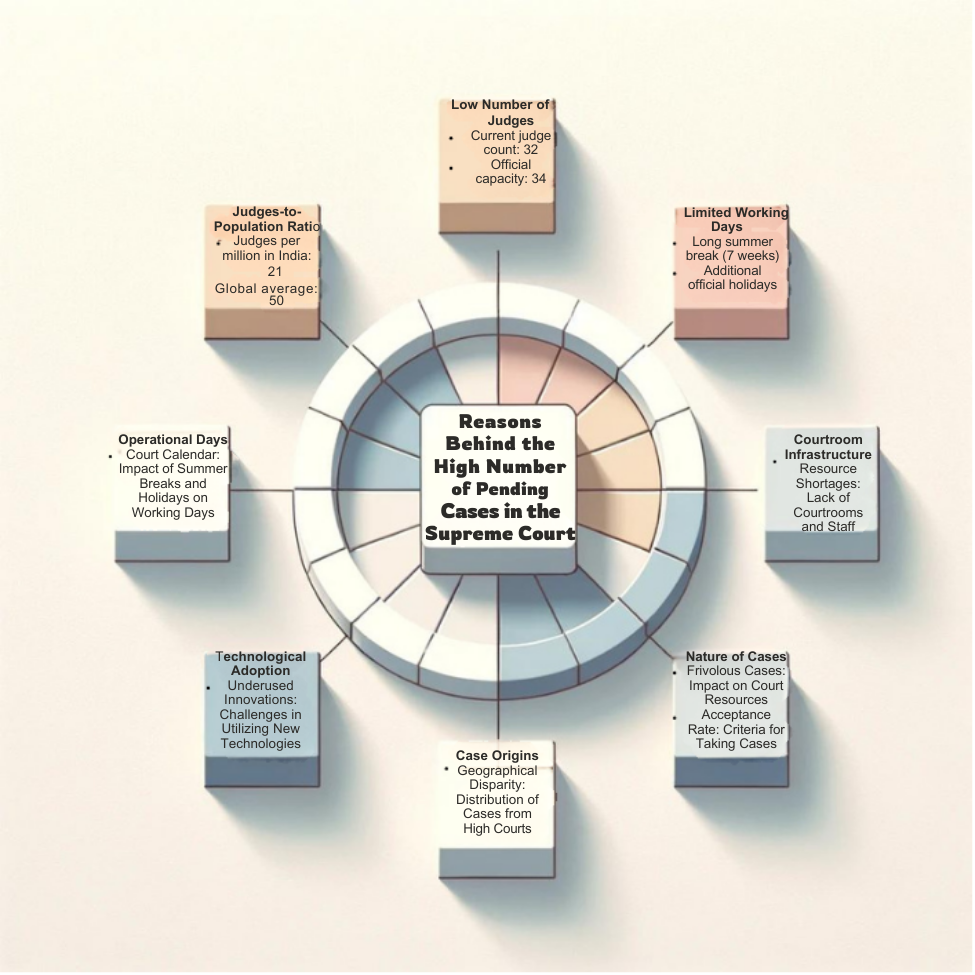
Low Number of Judges: One big reason for the large number of pending cases is that the Supreme Court doesn’t have enough judges. Although they’re supposed to have 34 judges, there are only 32 right now. That means they’re short by two judges.
Fewer Judges per People: Compared to other countries, India has very few judges per person. For every million people in India, there are only about 21 judges. The global average is 50 judges per million people. This means India has a shortage of judges.
Delays in Appointing Judges: The process of appointing judges is often slow. When the Supreme Court suggests someone to be a judge, the government sometimes takes a long time to agree.
Judges’ Absences: Sometimes, Supreme Court judges have to go to different events or take time off for health or personal reasons. This means they can’t hear cases as often as they should.
Summer Break and Other Holidays: The Supreme Court takes a long summer break every year, which lasts for about seven weeks. Also, they have other holidays during the year. This means they work for fewer days in a year than they could.
Not Enough Courtrooms and Staff: The Supreme Court doesn’t have enough courtrooms or staff. This makes it hard for them to handle all the cases efficiently.
Technology Issues: Even though the Supreme Court has introduced new technology to help with cases, like video calls and online filing, not many people use it. This slows down the process.
Cases from High Courts: Most of the cases that go to the Supreme Court come from High Courts that are close by. Cases from far away High Courts are fewer because it’s harder and more expensive to bring cases from there.
Frivolous or Unimportant Cases: Sometimes, people file cases in the Supreme Court that aren’t very important or are just meant to cause trouble. This takes up the Court’s time and resources.
High Rate of Accepting Cases: The Supreme Court accepts a lot of cases, even ones that might not be very important. This adds to the number of pending cases.
By addressing these issues, the Supreme Court can work more efficiently and reduce the number of pending cases.
Why in News: The Urgent Need to Revamp the Supreme Court’s Structure
The Supreme Court is facing a big problem with too many pending cases, around 80,000 of them. This has led to calls for major changes in how the court is structured. People are talking about this a lot because it affects how quickly justice is delivered across the country. The discussion is important for people preparing for the UPSC exam, as it dives into the history of the Supreme Court, its current challenges, and ideas for making it work better. These ideas include setting up courts in different regions and having the court work more days. Understanding these issues is crucial for anyone studying Indian Polity and is a big topic in the news right now.
The Supreme Court of India, with its 34 judges, faces an overwhelming backlog of approximately 80,000 cases, underscoring a critical challenge in the nation’s judicial system. This staggering number of pending cases not only reveals the acute strain on the judicial infrastructure but also underscores the pressing need for systemic reforms to enhance efficiency and streamline legal processes. The backlog represents a mix of civil and criminal matters, with a significant portion being civil cases. Despite the Court’s efforts to adjudicate over 36,000 cases in 2023 alone, the persistence of such a high volume of pending cases, including those over a decade old, demands urgent attention and action to uphold the principles of timely justice.
Proposed Reform Measures to Reduce Case Pendency
Division of Supreme Court
The Tenth Law Commission of India suggested dividing the Supreme Court into two parts: the Constitutional Division and the Legal Division. The idea is that only constitutional law matters would go to the Constitutional Division.
National Court of Appeal for SLPs
The Supreme Court, in the Bihar Legal Support Society v. Chief Justice of India case in 1986, mentioned the need for a National Court of Appeal. This court would handle special leave petitions (SLPs) and deal with constitutional and public law issues.
Regional Benches of Supreme Court
The 229th Law Commission Report in 2009 recommended setting up regional benches in Delhi, Chennai or Hyderabad, Kolkata, and Mumbai. These benches would focus on non-constitutional cases, leaving the Supreme Court to handle constitutional and nationally important cases.
Increase Work Days
The Malimath Committee proposed that the Supreme Court work for 206 days a year and reduce vacation time by 21 days. Similarly, the 2009 Law Commission suggested cutting vacation time by 10-15 days across all levels of the judiciary to address the case backlog.
Final Court of Appeal and Permanent Constitution Bench
Dividing the Supreme Court’s workload into a Final Court of Appeal and a permanent Constitution Bench would ensure better judicial stability and consistency. This would clarify which cases fall under constitutional authority and which are for appeals or reviews.
Dedicated Authority for Infrastructure
Former CJI NV Ramanna suggested creating the National Judicial Infrastructure Authority of India (NJIAI) to improve judicial infrastructure across the country, which is currently in urgent need of attention.
Conclusion
The massive backlog of cases in the Supreme Court signals an urgent call for reform. Tackling problems like the lack of judges, poor infrastructure, and unnecessary appeals is key to reducing delays. Solutions like extending court workdays, setting up regional benches, and considering specialized courts could improve efficiency and make the judiciary more accessible to everyone. By adopting these changes, India’s judiciary can become more responsive and effective, ensuring justice is delivered without long and frustrating delays.

